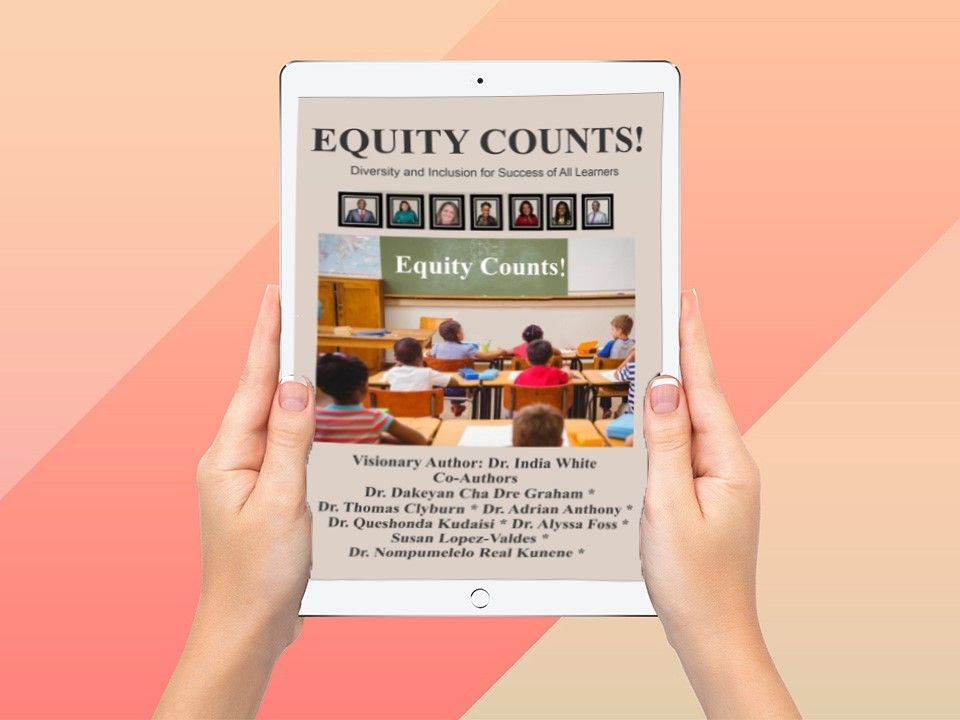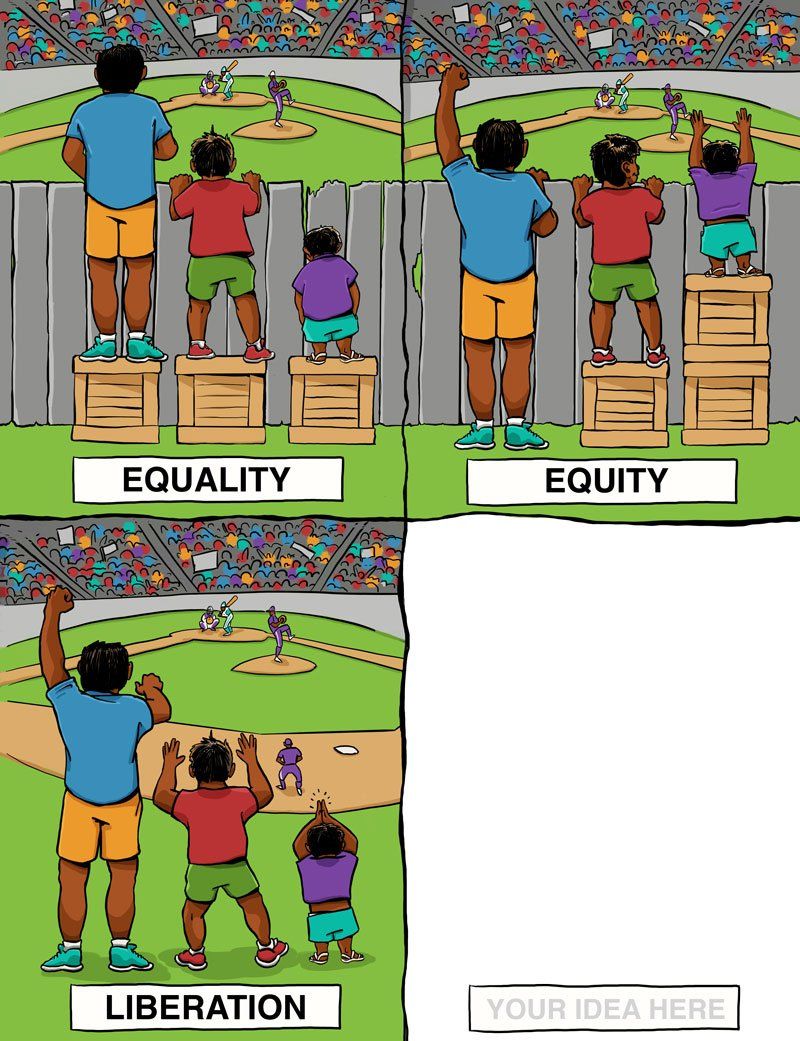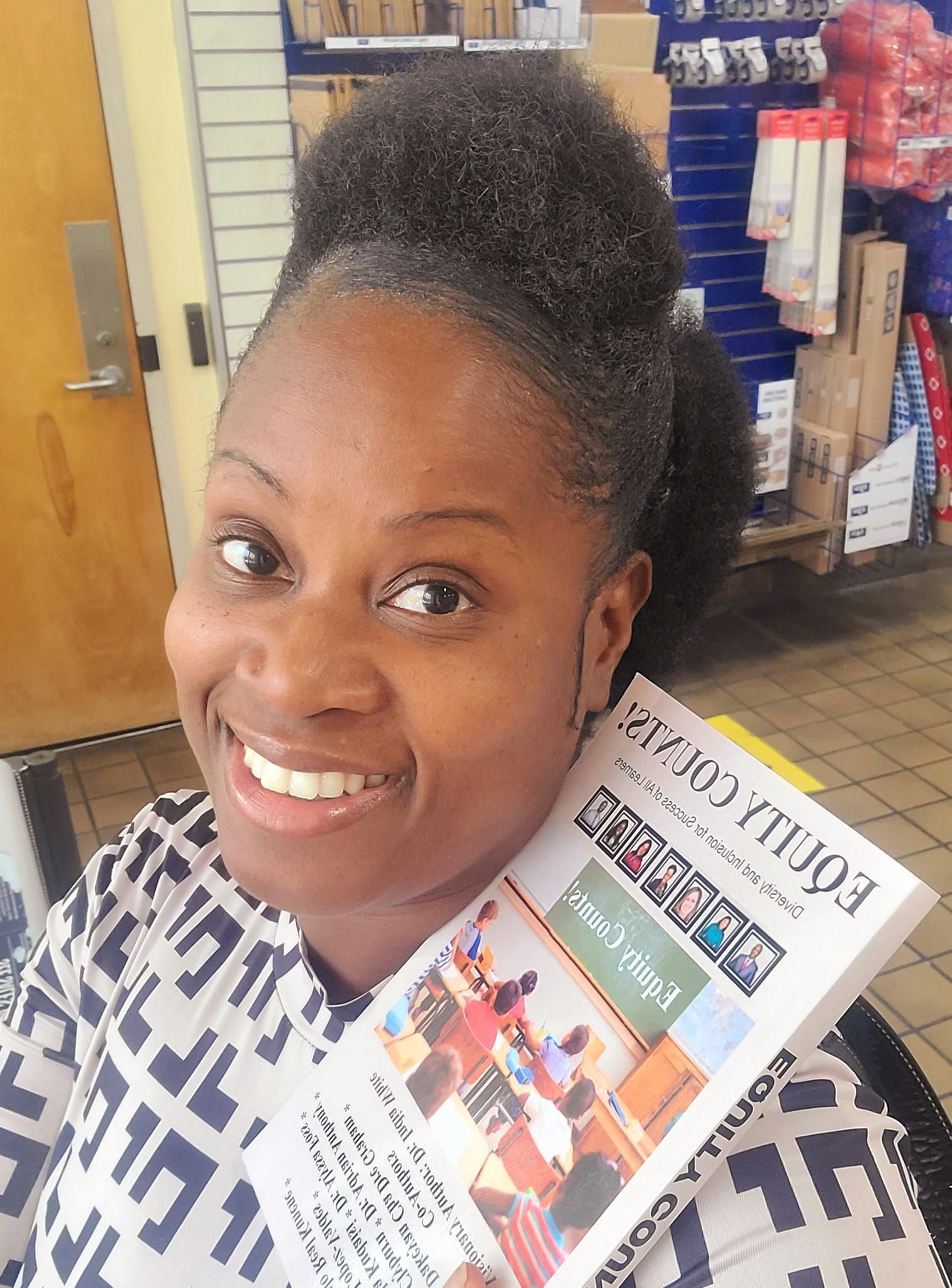Celebrating Culture and Race: Establishing Equitable Math Practices in the Classroom
India White • September 5, 2023
Celebrating Culture and Race through Equitable Math Practices!

Celebrating Culture and Race: Establishing Equitable Math Practices in the Classroom
In today's diverse classrooms, it is crucial for teachers to embrace and celebrate the cultural and racial backgrounds of their students. Currently, studies have shown that in schools where at least 90% of students were minorities, the share of teachers who were Hispanic was 28%, while 20% of teachers were Black, 5% were Asian and 43% were White. Across schools where at least 90% of students were White, nearly all teachers (97%) also were White.
With such a significant demographic gap, teachers must be equipped with tools to properly connect with and celebrate learners for varying ethnic backgrounds. Hence, by incorporating students' culture and race into math instruction, educators can create an inclusive learning environment that promotes equitable math practices. Let’s now explore the importance of celebrating culture and race in the math classroom and provide three tips supported by scholarly research to help teachers establish equitable math practices.
1. Incorporate Culturally Relevant Math Tasks
Research has shown that incorporating culturally relevant math tasks can enhance students' engagement and achievement in mathematics
(Gutiérrez, 2013). In her article titled, Mathematics Teachers’ Use of the Culturally Relevant Cognitive Demanding Mathematics Task Framework and Rubric in the Classroom, Central Connecticut State University Math Professor, who specializes in culturally relevance, Dr. Shelly Jones mentions how schools often do not meet the needs of culturally different students because there is not a social context for learning which would allow students of diverse backgrounds to access knowledge in ways that are comfortable and familiar to them. In efforts to combat the lack of relevance and cultural connection in the math classroom, teachers can select math problems or activities that reflect the cultural backgrounds and experiences of their students. For example, using real-life scenarios and prominent figures of various cultural groups that relate to students' cultures or incorporating culturally diverse mathematicians and their contributions can help students see the relevance of math in their own lives (NCTM, 2018).
This approach not only promotes cultural appreciation but also helps students connect math concepts to their own experiences, making learning more meaningful. As teachers guide students through math with a culturally relevant lens, it will increase the sense of belonging and math identity of all learners.
2. Foster Collaborative Learning and Discussion
Creating opportunities for collaborative learning and discussion can promote equity in the math classroom. Research suggests that collaborative learning environments can help students develop a deeper understanding of mathematical concepts and improve problem-solving skills
(Cohen & Lotan, 2014). Hence, teachers should encourage students to work in groups with diverse students, where they can exchange their cultural perspectives and approaches to problem-solving. As they do this, students will grasp a stronger sense of knowledge of the content, and benefit from the mathematical discourse experienced with their peers. Further, it will support teacher in their efforts to build a healthy metacognitive flow as teachers scaffold learners into thinking about their thoughts and thinking about the math. Cohen and Lotan (2014) mention how teachers can utilize this in group discussions, stating that it is “important that the group discussion be articulate and thoughtful” …and that “teachers should consider using a specific skill builder designed to teach the kinds of “talk” you want to hear (p. 48).” By valuing and respecting each student's contributions, teachers can create an inclusive space where all voices are heard and valued.
3. Provide Culturally Responsive Assessment
Assessment plays a crucial role in promoting equitable math practices. Teachers should ensure that their assessment methods are culturally responsive and fair to all students. For example, offering multiple ways for students to demonstrate their understanding of math concepts,
such as through written work, oral presentations, or visual representations, can accommodate different learning styles and cultural preferences (NCTM, 2018). Further, teachers should include real-world examples that embrace various cultural groups and ethnic activities and ideas that could enhance appreciation of various cultures for all students. These should be intentional efforts that are factored in such that all learners can see themselves in the math, gain confidence in their own ability, know that they belong,
and that their cultural group is comprised of distinguished leaders who’ve accomplished great contributions in STEM fields and other areas that are notable in society.
Additionally, teachers should be mindful of potential biases
in assessment questions or grading practices that may disadvantage certain cultural or racial groups, along with any biases that they may be working through. Regularly reviewing and reflecting on assessment practices can help teachers identify and address any potential inequities. As educators make sure that they have utilized their time and resources to provide a culturally responsive assessment that fits the needs of all learners, they can be assured that they will provide equity and access for all students when they need it the most during each assessment.
Conclusion
Celebrating culture and race in the math classroom is essential for establishing equitable math practices during instruction. By incorporating culturally relevant math tasks, fostering collaborative learning and discussion, and providing culturally responsive assessments for all students, teachers can create an inclusive environment where all students feel valued and empowered to succeed. Further, they will strengthen each students’ sense of belonging and increase their level of confidence as independent math thinkers. Embracing diversity and promoting equity in math education not only enhances students' learning experiences but also prepares them to thrive in a multicultural world. Choose to celebrate culture and race in your math classroom today!
References
Cohen, E. G., & Lotan, R. A. (2014). Designing Groupwork: Strategies for the
Heterogeneous Classroom (3rd ed.). Teachers College Press.
Gutiérrez, R. (2013). The Sociopolitical Turn in Mathematics Education. Journal of Research
in Mathematics Education, 44(1), 37-68.
Jones, Shelly, "Mathematics Teachers’ Use of the Culturally Relevant Cognitively
Demanding Mathematics Task Framework and Rubric in the Classroom" (2015). NERA Conference Proceedings 2015. 12.
https://digitalcommons.lib.uconn.edu/nera-2015/12
National Council of Teachers of Mathematics (NCTM). (2018). Catalyzing Change in High
School Mathematics: Initiating Critical Conversations. Reston, VA: NCTM.
New ParagraphWan more? Get Your Signed Copy of Equity Counts Book Collaboration today!!

Making Grit Work at the Making Math Moments Summit: A Recap of a Powerful, Grit-Filled Experience Today, I had the incredible privilege of speaking at the Making Math Moments Summit, and it was truly amazing. From the moment we began, the energy was high, the curiosity was alive, and the commitment to transforming mathematics instruction through grit was stronger than ever. Even when we faced unexpected tech challenges, we modeled exactly what we teach: push through with perseverance, adapt with resilience, and keep moving forward. And yes, we did it with purpose and grit. Our theme for this session was Making Grit Work, and as we dove into the heart of the conversation, it quickly became clear that educators everywhere are hungry for tools that build students’ internal strength, not just their academic skills. Together, we explored what grit looks like in real classrooms, how we can cultivate it intentionally, and why it matters more than ever in today’s educational climate. One of the highlights of our time together was examining NAEP data and discussing how grit intersects with student performance nationwide. We didn’t shy away from the tough questions. We talked about the gaps, the realities, and most importantly, the opportunities. Grit is more than a concept; it is a framework for empowerment, a path toward confidence, and a catalyst for closing achievement gaps. It is the heartbeat of productive struggle. And today, everyone in that virtual room felt it. We also took the Grit Assessment, and that activity added an exciting layer of personal reflection. Educators saw where they personally shine in the pillars of my G.R.I.T. framework: Growth Mindset, Resilience, Self-Efficacy, and Time Management, as well as where they may want to grow further. The chat was full of insights, laughter, and “aha” moments as teachers rated themselves honestly and bravely. It reinforced why this work matters: before we can build grit in our students, we must first understand our own. What I loved most about this session was witnessing educators from all over the world lean in, reflect deeply, and commit to creating classrooms where students don’t just survive math, they rise in it. With every activity, discussion, and shared experience, the Grit Tribe grew bigger and stronger. I left the session inspired, grateful, and fired up for what’s ahead. Thank you to every educator who showed up, engaged, asked questions, and embraced grit with an open mind and open heart. Your dedication to your students and to your own professional growth is what keeps this movement alive. Let’s keep pushing forward, keep believing in ourselves and our students, and keep making grit work in every math moment. Stay gritty, Dr. India White
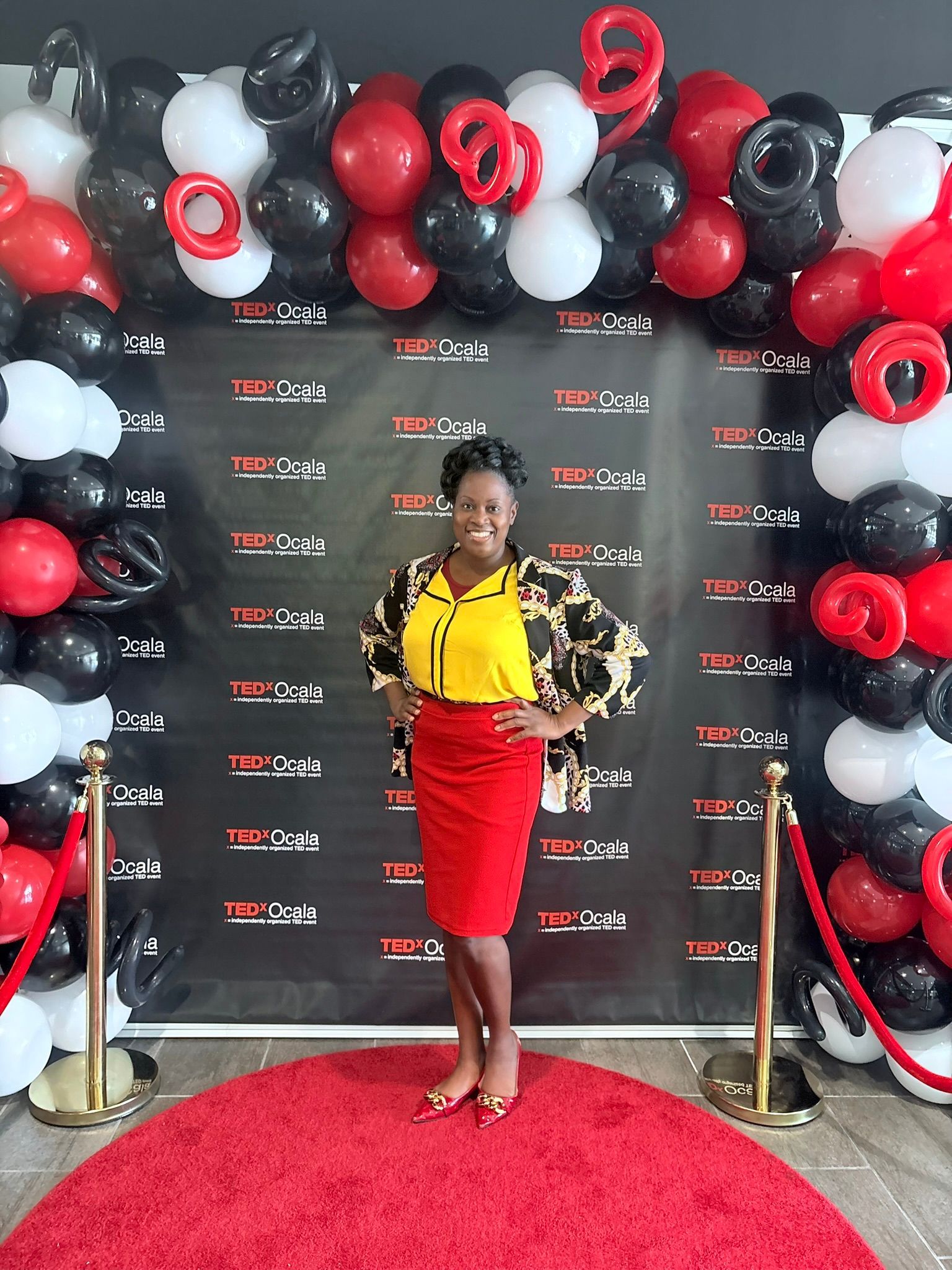
Attending TEDxOcala 2025: A Full-Circle Moment of Gratitude and Grit Attending TEDxOcala 2025 was nothing short of inspiring. Surrounded by brilliant minds and creative thinkers from across the globe, I was reminded once again of the transformative power of ideas. The event was filled with energy, innovation, and a deep sense of purpose as speakers shared their journeys and insights that challenged, uplifted, and encouraged everyone present to think bigger and live with intention. For me, the experience was also deeply personal. Returning to the stage where I delivered my TEDx talk in 2022 on The Power of G.R.I.T. brought a wave of gratitude and nostalgia. Standing there again, I couldn’t help but reflect on how much growth has happened since that pivotal moment. That talk wasn’t just a speech—it was a testimony to perseverance, resilience, and faith. It was a declaration that through Growth Mindset, Resilience, Self-Efficacy, and Time Management, we can overcome life’s toughest battles and rise into our purpose. Being back at TEDxOcala allowed me to reconnect with fellow visionaries, mentors, and new friends who continue to push the boundaries of what’s possible. It reminded me that we are truly better together. Collaboration and shared wisdom are what make communities thrive. Every person in that room carried a spark that contributed to something greater—an exchange of ideas that can ignite global change. Tips for Getting the Most Out of a TEDx Experience If you’ve ever wanted to attend a TEDx event or are planning to in the future, here are a few ways to make the most of it: 1. Be Present and Open-Minded. Listen with curiosity. Each speaker has a story, and sometimes the message that impacts you the most will come from an unexpected place. 2. Network with Purpose. TEDx events attract incredible people from all walks of life. Take time to connect, share your ideas, and build relationships that can lead to meaningful collaborations. 3. Reflect and Take Notes. Inspiration fades quickly if not captured. Write down key takeaways or quotes that resonate with you. Use them as fuel to inspire your work and personal growth long after the event. 4. Support the Speakers. Engage with them online, share their talks, and spread their messages. A simple act of encouragement can help amplify voices and causes that matter. 5. Apply What You Learn. The power of TEDx lies not just in listening but in doing. Let the ideas you hear challenge you to take action in your community, career, or personal life. How to Be Gritty in Your Career Attending TEDxOcala reminded me once again that grit is the bridge between inspiration and execution. Whether you’re an educator, entrepreneur, leader, or artist, your success depends not just on talent, but on your ability to persist through challenges. * Adopt a Growth Mindset: Believe that your skills and intelligence can be developed through effort and learning. * Build Resilience: View setbacks as opportunities to grow stronger, not reasons to give up. * Strengthen Self-Efficacy: Believe in your own ability to achieve goals—confidence fuels consistency. * Master Time Management: Prioritize purpose-driven actions each day to move closer to your vision. TEDxOcala 2025 was a beautiful reminder that the world changes when people dare to share their stories and embrace the grit it takes to make them real. As I left the event, my heart was full—thankful for the memories of 2022, the inspiration of 2025, and the reminder that we are all part of something much bigger than ourselves. We are better together. To learn more about my work on G.R.I.T. and how you can cultivate growth, resilience, self-efficacy, and time management in your journey, visit www.drindiawhite.com

Join me the week of November 14th as I speak for the Making Math Moments Virtual Conference!! 😃 I am excited to continue offering knowledge and sessions on grit and am open to traveling and working with schools, districts, and organizations as needed. Grit changes lives, and it’s my mission to make sure students and educators alike have the tools to thrive. As we step into this new season, I encourage you to reflect on where grit is showing up in your own life and in your work, and how you can be gritty in the upcoming NEW year. Together, let’s keep cultivating the power of G.R.I.T. in every classroom, community, and home. 😊 I'm here to support you and to work alongside you as we thrive and cultivate grit together. Visit my website www.india-white.com for more information and to see how we can work together 😊 . Link to Newsletter: https://lnkd.in/dpVxmaFp Get Your Spot at the MMM Conference: https://lnkd.in/dbCDkxvj hashtag#drindiawhite hashtag#grit hashtag#tedx hashtag#uf hashtag#savvas hashtag#teachers hashtag#students hashtag#principals hashtag#achievementgap hashtag#makingmathmoments Savvas Learning Company TEDxUniversity of Florida
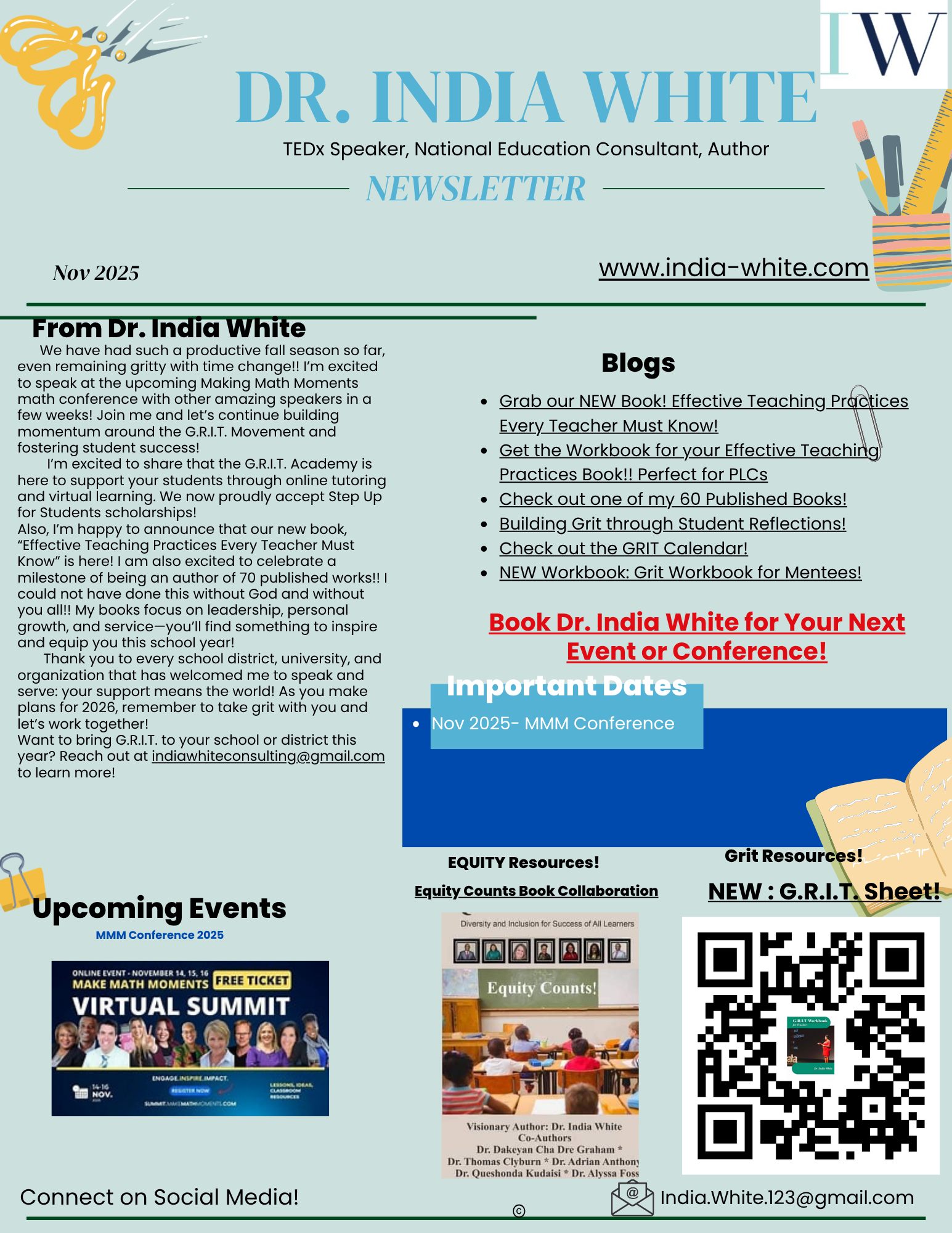
Woohoo! I'm Super Excited to Launch my Nov. 2025 Newsletter!! 😁 This past month, I had the joy of launching the Grit Workbook for Mentees and doing a book launch with some amazing teachers on our NEW Book and Workbook titled, "Effective Teaching Practices Every Teacher Must Know" 👏 . As a result, I crossed a new milestone of being an author of 70+ published works! 🥰 (excluding math textbooks) and it was nothing short of powerful. Throughout the week, teachers engaged in activities designed to help them understand and apply the G.R.I.T. framework—Growth Mindset, Resilience, Self-Efficacy, and Time Management. 😎 I want to thank each and every one of you for being there with me on this journey as we spread the message of building grit across the nation. 🥰 I can think of several teachers, leaders, and organizations who held my hand through the process and for that I remain forever grateful. By the end of the week, it was clear that these new works have equipped teachers and students for success in life. 😊 Join me the week of November 14th as I speak for the Making Math Moments Virtual Conference!! 😃 I am excited to continue offering knowledge and sessions on grit and am open to traveling and working with schools, districts, and organizations as needed. Grit changes lives, and it’s my mission to make sure students and educators alike have the tools to thrive. As we step into this new season, I encourage you to reflect on where grit is showing up in your own life and in your work, and how you can be gritty in the upcoming NEW year. Together, let’s keep cultivating the power of G.R.I.T. in every classroom, community, and home. 😊 I'm here to support you and to work alongside you as we thrive and cultivate grit together. Visit my website www.india-white.com for more information and to see how we can work together 😊 . Link to Newsletter: https://lnkd.in/dpVxmaFp Get Your Spot at the MMM Conference: https://lnkd.in/dbCDkxvj hashtag#drindiawhite hashtag#grit hashtag#tedx hashtag#uf hashtag#savvas hashtag#teachers hashtag#students hashtag#principals hashtag#achievementgap hashtag#makingmathmoments Savvas Learning Company TEDxUniversity of Florida

New Book Launch: The G.R.I.T. Prayer Guide for Apostolic Believers — Now Available on Amazon I’m thrilled to announce the release of my newest devotional, The G.R.I.T. Prayer Guide for Apostolic Believers, now available on Amazon. Order your copy here: https://www.amazon.com/dp/B0FXS7FZSY?ref_=pe_93986420_774957520 This 365-day devotional and prayer journal was written for Apostolic believers who are striving to live a holy, Spirit-led life while growing in perseverance, prayer, and power. Built upon the biblical foundation of Acts 2:38-39; Acts 2:42, this guide invites you to strengthen your walk with God by developing daily habits of prayer, reflection, and spiritual growth. The G.R.I.T. Prayer Guide for Apostolic Believers is more than a journal—it’s a spiritual journey designed to help you build G.R.I.T., which stands for: * Growth Mindset – Renew your mind daily through the Word, embracing God’s promises with faith and expectation. * Resilience – Stand strong in the Apostolic faith, enduring trials with steadfastness and joy in the Holy Ghost. * Self-Efficacy – Believe that through the Spirit, you can live victoriously, walking in righteousness and truth. * Time Management – Dedicate daily time to prayer, fasting, worship, and studying the Scriptures to stay spiritually disciplined. This prayer guide empowers Pentecostal and Apostolic believers to pursue holiness and purpose. Each day includes space for prayer, reflection, and gratitude— helping you cultivate a lifestyle of devotion that keeps your heart fixed on God. Whether you are new to the faith or a seasoned believer, this devotional is a valuable resource to help you stay anchored in God’s Word, develop endurance, and walk boldly in Apostolic identity. As you journey through the year, you will find yourself strengthened by Scripture, renewed in purpose, and ignited with spiritual fire. Just as I shared in my TEDx Talk, “The Power of G.R.I.T.,” this guide reminds us that G.R.I.T. means Great Resilience In Time. Through prayer and daily devotion, Apostolic believers can develop the spiritual resilience needed to withstand the storms of life while staying faithful to the Lord’s calling. Use this devotional as part of your morning or evening prayer routine, during fasting seasons, or in group study with fellow believers. Let it become a tool that draws you deeper into the presence of God and helps you grow in both discipline and anointing. Order Your Copy Today The G.R.I.T. Prayer Guide for Apostolic Believers is now available on Amazon at: https://www.amazon.com/dp/B0FXS7FZSY?ref_=pe_93986420_774957520 May this guide strengthen your walk with God, deepen your prayer life, and help you live with Great Resilience In Time—for His glory. For ministry connections, speaking engagements, or more G.R.I.T. resources, visit me at www.india-white.com. Grab Your Copy from Amazon Today!

New Book Launch: The G.R.I.T. Journal for Apostolic Believers — A 365-Day Journey of Prayer, Power, and Purpose I am overjoyed to announce the release of my newest devotional resource, The G.R.I.T. Journal for Apostolic Believers! This powerful 365-day journal was prayerfully designed to help Apostolic Christians strengthen their walk with God through daily devotion, reflection, and intentional growth in holiness. In a world filled with distractions and compromise, Apostolic believers are called to stand firm in truth and righteousness. This journal serves as a spiritual companion to help you cultivate a life that is rooted in the Apostles’ doctrine, empowered by the Holy Ghost, and aligned with God’s will. The G.R.I.T. Framework —Growth Mindset, Resilience, Self-Efficacy, and Time Management —provides a faith-based structure for spiritual discipline and endurance. As you journey through the pages, you will be inspired to: * Grow daily in your knowledge of the Word, prayer, and Apostolic doctrine. * Develop Resilience to remain steadfast in your faith, even when faced with trials or opposition. * Strengthen Self-Efficacy, trusting that through the Holy Ghost you have the power to live a victorious life. * Manage Your Time with intention, dedicating each day to prayer, worship, fasting, and service for the Lord. This journal is built on the foundation of **Acts 2:42**, where the early church “continued steadfastly in the apostles’ doctrine and fellowship, and in breaking of bread, and in prayers.” Each page encourages you to take time daily to seek God’s presence, apply Scripture, and live a life that pleases Him. The G.R.I.T. Journal for Apostolic Believers promotes Pentecostal holiness living—separation from the world, consecration unto God, and a heart committed to righteousness. Through daily reflections, prayer journaling, and gratitude writing, you will draw closer to Jesus and be reminded of your purpose as a vessel for His glory. This journal can be used as part of your daily devotion, during morning prayer, in fasting seasons, or alongside Bible study. It is a tool to help you remain spiritually grounded and encouraged as you strive to walk in the Spirit and fulfill God’s calling on your life. Use it to: * Record your daily prayers, Scriptures, and answered petitions. * Reflect on how God is molding your character and faith. * Strengthen your spiritual focus through intentional journaling. * Prepare your heart for revival and continual renewal in the Holy Ghost. The G.R.I.T. Journal for Apostolic Believers was inspired by the same message I shared in my TEDx Talk, “The Power of G.R.I.T.”—which stands for Great Resilience In Time. For the Apostolic believer, this resilience is found in living for Christ daily, enduring trials with joy, and pressing toward the mark of the high calling of God in Christ Jesus. Order Your Copy Today The G.R.I.T. Journal for Apostolic Believers is now available on Amazon: Paperback copy! Whether you are a minister, prayer warrior, youth leader, or believer striving to please the Lord, this devotional will help you stay rooted in Apostolic truth and live a life that honors God in every thought, word, and deed. About the Author Dr. India White is a national speaker, educator, and author who passionately empowers believers to develop Great Resilience In Time through faith and spiritual discipline. As a baptized, Spirit-filled believer who lives by the Apostolic doctrine, she is dedicated to helping others grow in holiness, faith, and purpose. Through her ministry and her G.R.I.T. Framework, she equips the body of Christ to endure with strength, walk in integrity, and live a life of consecration to the Lord. To learn more or invite Dr. White to your church, conference, or women’s ministry event, visit [www.india-white.com]

New Book Launch: The G.R.I.T. Prayer Journal — A 365-Day Devotional Journey of Faith and Perseverance I am beyond excited to announce the launch of my newest book, The G.R.I.T. Prayer Journal: A 365-Day Devotional Journey! This journal was created to help believers strengthen their relationship with God, build spiritual endurance, and live with purpose every single day. The G.R.I.T. Prayer Journal is more than just a devotional—it’s a transformational journey designed to help you develop G.R.I.T., which stands for Growth Mindset, Resilience, Self-Efficacy, and Time Management. These four pillars are essential not only for success in life but also for spiritual maturity. As you walk through each day of this 365-day devotional, you’ll be encouraged to: * Grow in your faith and mindset by applying God’s Word to daily life. * Build Resilience by trusting God’s promises during times of struggle and uncertainty. * Develop Self-Efficacy, believing that you can do all things through Christ who strengthens you. * Manage Your Time Wisely, creating space each day to pray, reflect, and renew your spirit. This journal was born out of my own experiences with perseverance—the same message I shared in my TEDx Talk, “The Power of G.R.I.T.” In that talk, I reminded the world that G.R.I.T. stands for Great Resilience In Time—the ability to endure, overcome, and rise stronger through every challenge life presents. The same faith and determination that carried me through seasons of difficulty have been woven into the pages of this devotional. Every page of The G.R.I.T. Prayer Journal invites you to reflect on Scripture, record your prayers, and recognize how God is moving in your life. It’s designed for believers who want to deepen their walk with God, grow in faith, and live each day with hope and purpose. Whether you are just starting your faith journey or have been walking with the Lord for years, this devotional will help you remain steadfast, prayerful, and full of grace. Order Your Copy Today The G.R.I.T. Prayer Journal is now available on Amazon today! Paperback For speaking engagements, ministry collaborations, or to learn more about my G.R.I.T. Framework and resources, please visit my website or contact me directly. About the Author Dr. India White is a national speaker, educator, author, and TEDx presenter known for her inspiring message of perseverance and faith. As the founder of G.R.I.T. Academy, she empowers students, leaders, and believers to grow through challenges and build lasting resilience.
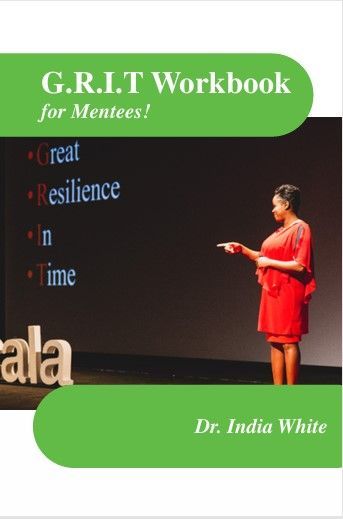
# The Power of Grit in Mentoring: A Leader’s Playbook for Building Perseverance, Confidence, and Achievement Mentoring changes lives when it moves beyond encouragement and becomes a disciplined, relationship-centered system for **building grit**—the daily habits of perseverance that help mentees finish what they start, grow through setbacks, and become resilient, self-directed learners. In my **G.R.I.T. Framework**—**Growth Mindset, Resilience, Self-Efficacy, and Time Management**—mentors learn to coach behaviors and beliefs that compound over time. This blog synthesizes what research says about grit and mentoring, translates those findings into practical tools for mentors, and shows leaders how to implement a high-fidelity mentoring model in schools, districts, churches, nonprofits, and teams. It also points to resources in my **GRIT Workbooks** and **GRIT Trainings**, and it connects with principles from my **TEDx talk, “The Power of Grit.”** Leaders: share this with your mentor corps. Every section below includes specific actions and measurable indicators you can put to work right away. --- ## Why Grit Matters in Mentoring (What the Evidence Actually Shows) Across multiple contexts, grit—defined as “perseverance and passion for long-term goals”—predicts meaningful differences in success. In seminal studies, grit accounted for about **4% of the variance** in outcomes such as Ivy League GPA, **West Point** retention, educational attainment, and **National Spelling Bee** rankings (Duckworth 2007). Importantly, follow-up research at West Point shows that **both** initial fitness and grit significantly predict **four-year retention** through graduation, underscoring that noncognitive traits and tangible preparation work together (Wetzler et al. 2023). At the same time, the strongest meta-analysis to date urges nuance: the **perseverance-of-effort** facet (showing up and doing the work) tends to carry more predictive weight than the **consistency-of-interests** facet, and grit overlaps with conscientiousness more than early popular narratives suggested (Credé, Tynan, and Harms 2017). For leaders, the takeaway is practical: coach **repeatable effort routines** and **structured practice**, not slogans. Grit connects tightly to other malleable drivers. A national, randomized study of U.S. high schools found a brief **growth-mindset** intervention improved grades **for lower-achieving students** and increased enrollment in advanced math, **when schools provided supportive contexts**—clear work routines, challenge with care, and timely feedback (Yeager et al. 2019). A meta-analysis on mindsets also concluded that average effects are **small overall** but stronger for at-risk learners and when paired with concrete supports (Sisk et al. 2018). This is a crucial design lesson for mentoring: pair belief-shifts with **structure**. Two more pillars round out the picture. **Self-efficacy**—students’ belief in their ability to execute tasks—shows **robust, positive relations** with academic performance and persistence across decades of research (Multon, Brown, and Lent 1991; Artino 2012). And **time management** routines reliably improve engagement, reduce stress, and relate to performance, especially when defined as **specific planning behaviors** (Aeon and Aguinis 2017; Aeon, Faber, and Panaccio 2021). Newer work continues to link time-planning habits to higher study engagement via improved self-control and reduced distraction (Fu et al. 2025). Finally, **mentoring itself works**—and works best when it follows evidence-based practices. Meta-analyses show **modest average effects overall**, with **larger effects** when programs build high-quality relationships, set clear goals, and use structured activities (DuBois et al. 2011; Eby et al. 2008; Raposa et al. 2019). For leaders, that means your implementation fidelity—not just your enthusiasm—determines your impact. --- ## The G.R.I.T. Framework for Mentors (What to Coach and How) **Growth Mindset.** Mentors help mentees interpret effort and struggle as **signals for strategy change**, not signs of incapacity. Replace “I’m not good at this” with “I’m not there **yet**—what’s my next step?” Pair language with specific practice plans, because mindset effects scale **when** learners get structured opportunities to practice and see improvement (Sisk et al. 2018; Yeager et al. 2019). Three to four sentences of encouragement cannot substitute for a calendar of deliberate work. **Resilience.** Reframe setbacks using a two-question reset: **What did I try? What will I try next?** Evidence from competitive contexts shows that gritty performers invest in **deliberate practice**—effortful, targeted repetitions with feedback—even when it’s not enjoyable. In the National Spelling Bee, deliberate solo practice predicted performance better than quizzing or leisure reading, and time in deliberate practice **mediated** the link between grit and outcomes (Duckworth et al. 2010/2011). Mentors should therefore normalize “productive discomfort” and monitor the **dose** of high-quality practice. **Self-Efficacy.** Confidence grows through **mastery experiences**—visible progress on tasks. Mentors should break complex goals into **manageable skills**, track micro-wins, and spotlight progress evidence (“You solved 6/10 correctly last week and 8/10 today after switching strategies”). This is the mechanism by which efficacy fuels persistence and performance (Multon, Brown, and Lent 1991; Artino 2012). **Time Management.** Grit needs a calendar. Adopt a weekly rhythm: two to three **30-minute focus blocks**, a **review/reflect** block, and **micro-deadlines**. The literature shows that when “time management” is treated as specific planning behaviors—rather than a vague trait—benefits are clearer for well-being, engagement, and performance (Aeon and Aguinis 2017; Aeon, Faber, and Panaccio 2021; Fu et al. 2025). --- ## A Six-Step Mentoring Playbook (Leader-Ready and Measurable) **Step 1 — Define one outcome and two behaviors.** Clarify a concrete goal (e.g., “Raise Algebra quiz average from 68% to 78% in four weeks”) and two behaviors that produce it (“Complete three targeted practice sets per week; attend one help session”). Clarity fuels efficacy and execution (Multon, Brown, and Lent 1991). **Step 2 — Build a weekly plan.** Schedule **two focused blocks** and one **review block** on the mentee’s calendar. Treat practice like a rehearsal—non-negotiable and protected. Research suggests that structured planning is the tractable unit of “time management” that mentors can coach consistently (Aeon and Aguinis 2017; Aeon, Faber, and Panaccio 2021). **Step 3 — Practice deliberately.** Use **model → guided reps → independent reps** with tight feedback loops. Keep challenge just above current skill. In high-stakes learning, deliberate practice—not generic repetition—drives the gains that gritty students realize (Duckworth et al. 2010/2011). **Step 4 — Track micro-wins.** Use a single-page tracker: attempts, errors spotted, fixes tried, score trend. Visible progress is the fuel for self-efficacy, and self-efficacy, in turn, sustains persistence (Multon, Brown, and Lent 1991; Artino 2012). **Step 5 — Debrief with AAA: Acknowledge, Analyze, Adjust.** Affirm effort (“You protected your study blocks”), analyze strategy (“What worked?”), then adjust (“Next week: swap one 30-minute block to mornings”). This keeps the relationship warm and the expectations high—two hallmarks of effective mentoring programs (DuBois et al. 2011; Raposa et al. 2019). **Step 6 — Protect the relationship.** Set predictable check-ins and open with a brief relational scan (“High/Low of the week?”). Meta-analytic reviews show that relationship quality magnifies mentoring effects across domains (Eby et al. 2008; Raposa et al. 2019). Leaders should train mentors to balance **care** with **challenge** every week. --- ## Field-Tested Tips Mentors Can Use Tomorrow **Make struggle normal and specific.** Say: *“This is hard because you’re learning. Let’s try a smaller step and track it.”* Then define the step and where it goes on the calendar. This converts a mindset cue into a behavior (Sisk et al. 2018; Yeager et al. 2019). **Coach the dose of practice.** Ask: *“Show me 20 minutes of deliberate reps on the three hardest problem types, then text me your tracker.”* In competitive settings, deliberate practice time is the pathway through which grit shows its effect (Duckworth et al. 2010/2011). **Anchor confidence in evidence.** Prompt: *“Identify one place you improved since last week, and what you changed to get there.”* Efficacy grows when improvement is linked to controllable strategies (Multon, Brown, and Lent 1991; Artino 2012). **Keep time visible.** Mentor: *“Open your planner—where are the two 30-minute blocks this week?”* Mentoring that operationalizes time as scheduled behaviors produces more reliable gains (Aeon and Aguinis 2017; Aeon, Faber, and Panaccio 2021; Fu et al. 2025). --- ## Measuring Impact (So Leaders Can See What’s Working) Build a simple dashboard that blends **outcomes**, **process**, and **beliefs**: * **Outcome metrics:** course grades, attendance, certification steps completed, or project milestones. * **Process metrics:** number of focused study blocks completed; number of deliberate-practice reps; number of mentor feedback cycles per week. * **Belief metrics:** 4-item pulse on growth mindset and self-efficacy (e.g., “I can improve with practice; I know my next step”). Track weekly. Coach **behavioral fidelity** first (Did we do the blocks? the reps? the debriefs?) before adjusting goals. This mirrors what high-impact mentoring programs do at scale—focus on the controllables, then iterate (DuBois et al. 2011; Raposa et al. 2019; Eby et al. 2008). --- ## Implementation Pitfalls Leaders Should Avoid (And What to Do Instead) **Pitfall 1: “Mindset talk” without practice plans.** **Fix:** Pair every encouragement with a **specific, scheduled action**. The strongest studies show mindset affects achievement most when aligned with structure and supportive contexts (Yeager et al. 2019; Sisk et al. 2018). **Pitfall 2: Treating grit as personality, not practice.** **Fix:** Emphasize the **perseverance-of-effort** behaviors. Remember that grit overlaps with conscientiousness and works mainly through consistent, high-quality effort (Credé, Tynan, and Harms 2017). **Pitfall 3: Vague time-management advice.** **Fix:** Define time management as **two to three protected blocks + one review block + micro-deadlines**. Contemporary reviews favor concrete planning over broad platitudes (Aeon and Aguinis 2017; Aeon, Faber, and Panaccio 2021; Fu et al. 2025). **Pitfall 4: Relationship drift.** **Fix:** Train mentors to open with connection, close with commitments, and log each session. Meta-analyses consistently link **relationship quality** to larger effects (Raposa et al. 2019; Eby et al. 2008). --- ## How the GRIT Workbooks and Trainings Support Your Mentoring Program My **GRIT Workbooks** (Students, Educators, and Clergy) provide ready-to-use trackers, reflection prompts, mentor scripts, and weekly planning pages aligned with the **G.R.I.T. Framework**. The tools are designed so mentors can implement the **six-step playbook** immediately and leaders can monitor fidelity with simple checklists. In **GRIT Trainings**, teams practice coaching micro-skills (e.g., moving from praise to evidence-based efficacy), calibrate deliberate-practice tasks in core subjects, and learn to set up dashboards that blend outcomes, process, and belief metrics. I also integrate key moments from my **TEDx talk “The Power of Grit,”** tailoring examples for schools, districts, youth ministries, and community organizations. For details, **visit my website** to explore coaching, keynotes, and full implementation support. --- ## A Final Charge to Leaders Grit is not a slogan; it is a **system**—of beliefs, behaviors, and relationships, repeated weekly, measured carefully, and refined relentlessly. When mentors coach **Growth Mindset** with structure, build **Resilience** through deliberate practice, cultivate **Self-Efficacy** with visible mastery, and protect **Time** on the calendar, mentees don’t merely cope—they **excel**. The research is clear that effects are **real but modest** on average; the magic happens when leaders insist on fidelity to **high-quality routines** and **caring, high-expectations relationships**. Equip your mentors with the GRIT playbook, and watch perseverance, confidence, and achievement rise—one well-planned week at a time. If you want a plug-and-play mentor toolkit, a GRIT keynote, or a customized training and evaluation plan for your organization, reach out. I’d be honored to help your mentors—and mentees—grow strong, finish well, and shine. --- ## References (Chicago Author–Date) Aeon, Brad, and Herman Aguinis. 2017. “It’s About Time: New Perspectives and Insights on Time Management.” *Academy of Management Perspectives* 31 (4): 309–30. [https://doi.org/10.5465/amp.2016.0166](https://doi.org/10.5465/amp.2016.0166). ([Academy of Management Journals][1]) Aeon, Brad, Thomas Faber, and Alexander Panaccio. 2021. “Does Time Management Work? A Meta-Analysis.” *PLOS ONE* 16 (1): e0245066. [https://doi.org/10.1371/journal.pone.0245066](https://doi.org/10.1371/journal.pone.0245066). ([PLOS][2]) Artino, Anthony R., Jr. 2012. “Academic Self-Efficacy: From Educational Theory to Instructional Practice.” *Perspectives on Medical Education* 1 (2): 76–85. [https://doi.org/10.1007/s40037-012-0012-5](https://doi.org/10.1007/s40037-012-0012-5). ([PubMed Central][3]) Credé, Marcus, Michael C. Tynan, and Peter D. Harms. 2017. “Much Ado about Grit: A Meta-Analytic Synthesis of the Grit Literature.” *Journal of Personality and Social Psychology* 113 (3): 492–511. [https://pubmed.ncbi.nlm.nih.gov/27845531/](https://pubmed.ncbi.nlm.nih.gov/27845531/). ([PubMed][4]) DuBois, David L., Nelson Portillo, Jean E. Rhodes, Naida Silverthorn, and Jeffrey C. Valentine. 2011. “How Effective Are Mentoring Programs for Youth? A Systematic Assessment of the Evidence.” *Psychological Science in the Public Interest* 12 (2): 57–91. [https://doi.org/10.1177/1529100611414806](https://doi.org/10.1177/1529100611414806). ([PubMed][5]) Duckworth, Angela L. 2007. “Grit: Perseverance and Passion for Long-Term Goals.” *Journal of Personality and Social Psychology* 92 (6): 1087–1101. [https://pubmed.ncbi.nlm.nih.gov/17547490/](https://pubmed.ncbi.nlm.nih.gov/17547490/). ([PubMed][6]) Duckworth, Angela L., Teri A. Kirby, Eli Tsukayama, Heather Berstein, and K. Anders Ericsson. 2011. “Deliberate Practice Spells Success: Why Grittier Competitors Triumph at the National Spelling Bee.” *Social Psychological and Personality Science* 2 (2): 174–81. [https://doi.org/10.1177/1948550610385872](https://doi.org/10.1177/1948550610385872). ([SAGE Journals][7]) Eby, Lillian T., Tammy D. Allen, Sarah C. Evans, Thomas Ng, and David L. DuBois. 2008. “Does Mentoring Matter? A Multidisciplinary Meta-Analysis Comparing Mentored and Non-Mentored Individuals.” *Journal of Vocational Behavior* 72 (2): 254–67. [https://pmc.ncbi.nlm.nih.gov/articles/PMC2352144/](https://pmc.ncbi.nlm.nih.gov/articles/PMC2352144/). ([PubMed Central][8]) Fu, Yilin, Jiahui Yu, and Shuqin Li. 2025. “Unlocking Academic Success: The Impact of Time Management on College Students’ Study Engagement.” *BMC Psychology* 13 (1): 258. [https://pmc.ncbi.nlm.nih.gov/articles/PMC11967054/](https://pmc.ncbi.nlm.nih.gov/articles/PMC11967054/). ([PubMed Central][9]) Multon, Karen D., Steven D. Brown, and Robert W. Lent. 1991. “Relation of Self-Efficacy Beliefs to Academic Outcomes: A Meta-Analytic Investigation.” *Journal of Counseling Psychology* 38 (1): 30–38. [https://eric.ed.gov/?id=EJ426706](https://eric.ed.gov/?id=EJ426706). ([ERIC][10]) Raposa, Elizabeth B., Jean E. Rhodes, Sarah B. Stams, R. Schwartz, Carla Cardoso, et al. 2019. “The Effects of Youth Mentoring Programs: A Meta-Analysis of Outcome Studies.” *Journal of Youth and Adolescence* 48: 423–43. [https://www.rhodeslab.org/wp-content/uploads/2019/01/Raposa2019_Article_TheEffectsOfYouthMentoringProg.pdf](https://www.rhodeslab.org/wp-content/uploads/2019/01/Raposa2019_Article_TheEffectsOfYouthMentoringProg.pdf). ([rhodeslab.org][11]) Sisk, Victoria F., Alexander P. Burgoyne, Jingze Sun, Jennifer L. Butler, and Brooke N. Macnamara. 2018. “To What Extent and Under Which Circumstances Are Growth Mind-Set Interventions Effective? A Meta-Analysis of the Evidence.” *Psychological Science* 29 (4): 549–71. [https://journals.sagepub.com/doi/10.1177/0956797617739704](https://journals.sagepub.com/doi/10.1177/0956797617739704). ([SAGE Journals][12]) Wetzler, Elisheva L., Max Karstoft, John J. Ratey, Michael J. Matthews, and Yuval Neria. 2023. “Grit and Uncertainty: Grit Predicts Performance and West Point Graduation.” *Scientific Reports* 13: 11707. [https://pmc.ncbi.nlm.nih.gov/articles/PMC11407409/](https://pmc.ncbi.nlm.nih.gov/articles/PMC11407409/). ([PubMed Central][13]) Yeager, David S., Paul Hanselman, Gregory M. Walton, Jared S. Murray, Robert Crosnoe, et al. 2019. “A National Experiment Reveals Where a Growth Mindset Improves Achievement.” *Nature* 573 (7774): 364–69. [https://www.nature.com/articles/s41586-019-1466-y](https://www.nature.com/articles/s41586-019-1466-y). ([Nature][14]) --- *If you’d like this blog converted into a branded PDF, a leader’s one-pager, or a mentor session script packet aligned to the GRIT Workbooks (with trackers, planning pages, and fidelity checklists), say the word and I’ll package it for immediate use.* [1]: https://journals.aom.org/doi/10.5465/amp.2016.0166?utm_source=chatgpt.com "It's About Time: New Perspectives and Insights on ..." [2]: https://journals.plos.org/plosone/article?id=10.1371%2Fjournal.pone.0245066&utm_source=chatgpt.com "Does time management work? A meta-analysis | PLOS One" [3]: https://pmc.ncbi.nlm.nih.gov/articles/PMC3540350/?utm_source=chatgpt.com "Academic self-efficacy: from educational theory to instructional ..." [4]: https://pubmed.ncbi.nlm.nih.gov/27845531/?utm_source=chatgpt.com "Much ado about grit: A meta-analytic synthesis of the grit ..." [5]: https://pubmed.ncbi.nlm.nih.gov/26167708/?utm_source=chatgpt.com "How Effective Are Mentoring Programs for Youth? A ..." [6]: https://pubmed.ncbi.nlm.nih.gov/17547490/?utm_source=chatgpt.com "Grit: perseverance and passion for long-term goals" [7]: https://journals.sagepub.com/doi/10.1177/1948550610385872?utm_source=chatgpt.com "Deliberate Practice Spells Success" [8]: https://pmc.ncbi.nlm.nih.gov/articles/PMC2352144/?utm_source=chatgpt.com "Does Mentoring Matter? A Multidisciplinary Meta-Analysis ..." [9]: https://pmc.ncbi.nlm.nih.gov/articles/PMC11967054/?utm_source=chatgpt.com "Unlocking academic success: the impact of time management ..." [10]: https://eric.ed.gov/?id=EJ426706&utm_source=chatgpt.com "EJ426706 - Relation of Self-Efficacy Beliefs to Academic ..." [11]: https://www.rhodeslab.org/wp-content/uploads/2019/01/Raposa2019_Article_TheEffectsOfYouthMentoringProg.pdf?utm_source=chatgpt.com "The Effects of Youth Mentoring Programs: A Meta-analysis ..." [12]: https://journals.sagepub.com/doi/10.1177/0956797617739704?utm_source=chatgpt.com "To What Extent and Under Which Circumstances Are ..." [13]: https://pmc.ncbi.nlm.nih.gov/articles/PMC11407409/?utm_source=chatgpt.com "Grit and uncertainty: Grit predicts performance and West ..." [14]: https://www.nature.com/articles/s41586-019-1466-y?utm_source=chatgpt.com "A national experiment reveals where a growth mindset ..."

How to Find and Keep a Good Man — The Workbook Now on Amazon I am excited to announce the official launch of my newest workbook, How to Find and Keep a Good Man, now available on Amazon! This workbook was written to empower women of faith to grow in wisdom, discernment, and self-worth as they navigate relationships in today’s world. Whether you are single, dating, or preparing for marriage, this guide will help you build a strong foundation rooted in biblical principles, self-reflection, and emotional intelligence. Why I Wrote This Workbook Through my years of ministry, mentoring, and personal experience, I’ve seen countless women struggle with finding balance between faith, love, and self-respect. Many desire godly relationships but face challenges such as broken trust, poor communication, or settling for less than God’s best. This workbook was designed as a practical companion to my book How to Find and Keep a Good Man. It provides tools for healing, growth, and clarity so that women can walk confidently in God’s purpose for their relationships. Each chapter includes: *Scriptures to guide your faith walk * Reflections and journaling prompts for personal insight *Prayers and affirmations to strengthen your spirit * Action steps to apply biblical wisdom to real-life relationships What You’ll Discover In this workbook, you’ll explore topics such as: * The difference between a good man and a godly man * How to identify red flags before it’s too late * Building emotional maturity and setting healthy boundaries * How to become the woman God created you to be * Keys to sustaining love, respect, and trust over time Each activity and reflection helps you deepen your relationship with God and prepare your heart for the right partnership — one that honors Him and brings peace, not pain. A Journey of Faith, Grit, and Grace This project ties beautifully into my G.R.I.T. framework — Growth Mindset, Resilience, Self-Efficacy, and Time Management. Finding and keeping a good man requires growth, emotional resilience, confidence in your worth, and the discipline to wait on God’s timing. Through faith and grit, you can attract not just love, but lasting, purposeful connection. Available Now The How to Find and Keep a Good Man Workbook is now available on Amazon . Whether you’re doing this study alone, with a small group, or in a women’s ministry, this resource will help you reflect, heal, and prepare for the love God has for you. ( https://www.amazon.com/)
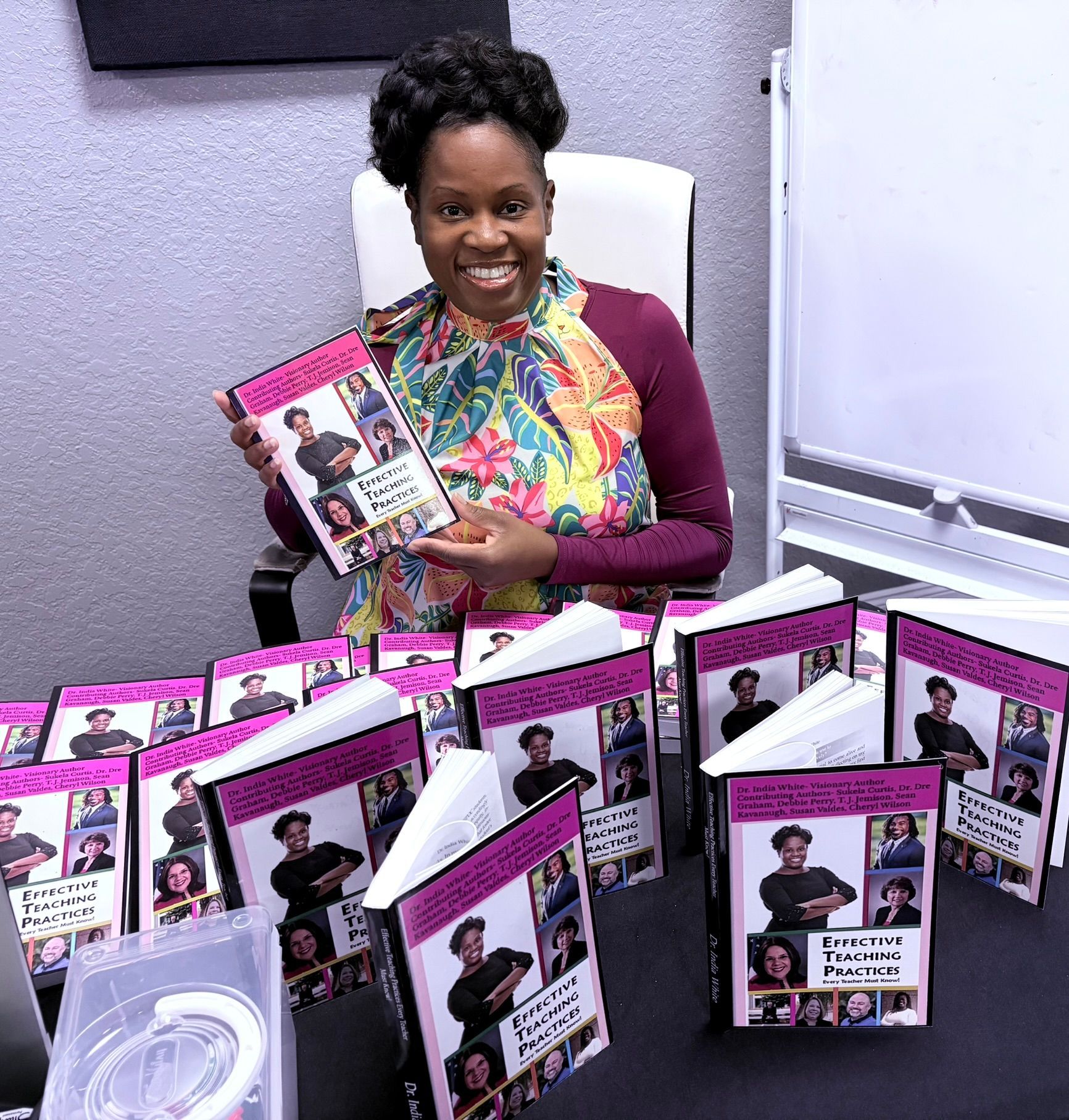
🚨 Exciting news! 📚 Our books have finally arrived, and orders are being shipped out! A huge thank you to the school districts and educators who have supported us by ordering their copies! 🙌 If you haven't grabbed yours yet, now's the time to get it! Don't miss out! Link- https://a.co/d/a6m9xoC ✨ hashtag#nctm hashtag#ncsm hashtag#drindiawhite hashtag#teachers hashtag#grit hashtag#Tedx
